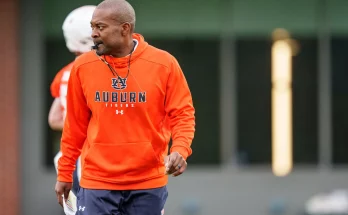Texas A&M’s Wide Receiver Battle Intensifies as Fall Camp Unfolds, Young Talent Emerges, and Veterans Fight to Hold Ground
As the scorching summer sun beats down on College Station, the air is thick with anticipation—not just from the heat but from the intensity brewing within Texas A&M’s fall camp. The Aggies’ wide receiver room has become one of the most fiercely contested position groups heading into the 2025 season. With new faces, emerging talent, and returning veterans all vying for a spot in the starting lineup, head coach Mike Elko and offensive coordinator Bobby Petrino are watching closely as competition brings out the best in a unit that could be the difference-maker in the SEC West race.
The departure of a few key playmakers from last season left a noticeable void in the Aggies’ passing attack. While the team was consistent at times, inconsistency at the quarterback and receiver positions kept the offense from reaching its full potential. Now, with renewed focus and deeper depth, the wide receiver battle in camp is shaping up to be one of the most important storylines of the preseason.
Evan Stewart, a junior who led the team in receiving yards last season despite missing time due to injury, enters camp as the most proven commodity in the receiver room. Stewart’s elite route-running, reliable hands, and explosive playmaking ability make him the presumed WR1. However, that’s where the certainty ends.
Sophomore Noah Thomas, who flashed tremendous upside last year, has come into fall camp with a chip on his shoulder. Towering at 6’6″ with deceptive speed, Thomas has been nearly uncoverable in red-zone drills, consistently high-pointing balls and outmuscling defensive backs. Coaches have taken note of his improved footwork and route refinement. He’s no longer just a big target—he’s evolving into a complete receiver, and that evolution could vault him into a starting role.
But Thomas isn’t the only sophomore causing waves. Micah Tease, who redshirted last year after joining as a highly-touted four-star recruit, is making a name for himself this August. Tease has been electric in the slot, displaying quick twitch movement and a knack for creating separation in short-yardage situations. His chemistry with projected starting quarterback Conner Weigman is evident during 7-on-7 periods, with Tease often being the go-to guy on third downs and key passing downs.
Then there’s freshman sensation Cameron Coleman, a five-star recruit out of Alabama who has wasted no time turning heads. Coleman’s combination of speed, agility, and football IQ has already earned him reps with the first team during the early stages of camp. Though still adjusting to the college game’s speed and physicality, Coleman’s ceiling appears limitless. His performance in fall scrimmages has drawn comparisons to some of the SEC’s elite pass catchers of recent years. If his current trajectory continues, he could carve out a significant role sooner rather than later.
Meanwhile, senior Moose Muhammad III remains a steady veteran presence. Muhammad’s route savvy and sure hands make him a trusted option, especially in clutch moments. While younger players may flash more explosiveness, Muhammad brings a consistency and professionalism that coaches value deeply. His leadership in the room has been crucial in helping the underclassmen acclimate to the demands of SEC football. However, even he is feeling the heat of competition, knowing every rep in camp could be the difference between starting and supporting.
One under-the-radar name that’s also begun to surface is Jordan Anthony, a transfer with track speed who brings a different dimension to the offense. His ability to stretch the field vertically has added a layer to the playbook that Petrino appears eager to utilize. Anthony’s straight-line speed forces safeties to respect the deep ball, potentially opening up intermediate routes for other receivers. If he continues to build rapport with Weigman, he could find himself in a key role by the time the Aggies face their first SEC opponent.
This intensified competition is being driven, in large part, by a new offensive philosophy. Under Petrino, the playbook is emphasizing tempo, spacing, and aggressiveness. That means more receivers on the field, quicker rotations, and the need for versatile skill sets. No longer will the team rely on just one or two key targets. Instead, the offense demands depth, and that depth is being tested daily in fall camp.
The receivers aren’t just battling each other—they’re being challenged by one of the SEC’s most promising defensive backfields. The iron-sharpens-iron dynamic has elevated practices, with corners like Deuce Harmon and Jayvon Thomas pushing receivers to execute at the highest level. The 1-on-1 drills have been must-watch moments at camp, with tempers flaring and competition reaching a fever pitch.
Conner Weigman’s growth as a quarterback also factors into this developing story. The more confident he becomes under center, the more he spreads the ball around. He’s no longer locking onto his first read, instead surveying the field and trusting multiple options. That confidence is giving more receivers opportunities to shine—and more chances to earn starting roles.
Still, with less than a month until the Aggies kick off their season against a tough non-conference opponent, time is of the essence. The coaching staff is expected to begin trimming down the rotation soon, solidifying who will run with the first-team offense. Those decisions will be based not just on performance, but on availability, consistency, and how well each player understands the playbook.
It’s worth noting that Petrino has been known to favor dynamic mismatches and situational packages, meaning the “starter” label might be more fluid than traditional depth charts suggest. A receiver might start in one set but come off the bench in another. This could be beneficial for the younger players, giving them opportunities to contribute without being overwhelmed.
Injuries, as always, will also play a role. With such a deep and talented group, the Aggies are in a better position than in recent years to withstand the inevitable bumps and bruises of an SEC schedule. That depth may be the key to keeping the offense humming deep into the season.
The tight receiver battle is also fostering a sense of urgency and accountability among the group. Film sessions have reportedly become more intense, with players not just focused on their own routes, but also giving feedback to teammates. The competitive environment is breeding not division, but cohesion—a shared belief that iron sharpens iron, and that the group as a whole will benefit from the challenge.
There’s a different energy at practice now. One that feels hungrier, more focused, and more dangerous. The Aggies are aware that in order to compete for an SEC title, their passing game needs to take the next step. And that step starts with this wide receiver corps reaching its full potential.
With every route run, every contested catch, and every rep against an aggressive secondary, the picture becomes a little clearer—but not entirely. The truth is, this battle might not be fully decided until Week 1, or even beyond. And for Texas A&M, that’s a good problem to have. Depth, competition, and talent across the board give them the kind of flexibility and explosiveness that could make this year’s offense one of the most dynamic in the conference.
As camp winds down and decisions loom, one thing is certain: the wide receiver room at Texas A&M is no longer a question mark. It’s a weapon—and one that’s still sharpening.



